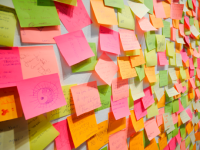Using Old Tech (Not Edtech) to Teach Thinking Skills
Butcher paper and Post-it notes can help students understand the collaborative thinking that takes place on a shared Google Doc.
I've been trying to use Google Docs to good effect in my ninth grade history classroom. It's a critical tool in that it lets me see the students puzzle out answers to their questions (especially with a heavy reliance of the "see revisions" function).
I've viewed classroom technology as the means to sharing knowledge, in addition to acquiring or manipulating it. Yet I find that not only has the computer itself become something of a distraction, but the students aren't making enough use of the tech’s "share-ability" -- that is, they struggle to work effectively together on it, and to have their ideas cohere in an intelligible way. It occurred to me that co-editing in a Google Doc is a skill that itself needs to be taught and practiced before it can become effective in the classroom.
I also started thinking that perhaps one fault of technology is that it brings the world to the student, rather than spurring the student to get up out the chair and go find it. I have noticed personalities in the class that like to work standing up, or who find reasons to walk around while thinking. Could there be a way to restore a kinesthetic element that had begun to disappear from the room with my reliance on web tools?
The Power of Post-it Notes
I believe that every student in the class can benefit from sharing knowledge and ideas with each other, whether it's through brainstorming or higher-level organizing and synthesizing, so I went back to ancient technology and made Google Docs analog again. I gave the students a large sheet of butcher paper, a pack of Post-it notes, and a few pens, and instructed them to draw a large T-chart on the butcher paper.
I then led them through a compare-and-contrast exercise with two documents from Imperial-era British East Africa -- one from the perspective of a colonial administrator and the other from a Kikuyu tribal chief. I wanted them to think about cause and effect in addition to perspective and bias, and how to reorganize information from a text into their own thoughts.
I asked them to begin writing down details from the documents that struck them as meaningful and important -- one detail to a Post-it note -- and put the notes in the right column with respect to the document from which it came. This let me walk around from group to group and push them a little to get less superficial in their note-taking -- to include specific details instead of just making general statements, for instance, or to avoid repeating the same vague comments.
One of Google Docs' functions that I value is how multiple people can edit at the same time -- or what might be called a form of both brainstorming and organization. So in step two of the exercise, I asked the students to start looking for natural groupings, arrange the Post-it notes by their similarities, and come up with a statement about the theme that linked those groupings together. This gave me the time I needed to meet with each group and to have them talk me through their thinking process. It helped them see the essential similarities and differences in the two accounts, and also the way in which the two documents recounted actions and consequences depending on how they worked across the T-chart.
Sharing Ideas
Here’s where the next function of the Google Docs -- its "share-ability" -- came in. I asked the students to perform a gallery walk and comment on each other's T-charts, filling in something that seemed missing or adding a comment or two to push the group's thinking further. As a reward for their efforts, each team could steal one or two Post-it notes from the other teams. That set off something of a frenzy as the students rushed to see what they could pillage from each other. One student wailed, "I hate being plagiarized!" That was a gratifying bonus.
Once the students returned with their swag and fit this new information into their charts, I asked each group to develop an overall statement that accounted for the similarities and differences in the two documents, or to the cause and effect relationship they saw developing between British actions and Kikuyu reactions. I heard someone say, "Oh, a thesis! That's how you do it!" What they had created, of course, was a deconstructed essay, and their final challenge was to construct a written argument from these charts.
It was a fun way to add some physical movement to what I had feared would be the standard, uninteresting document analysis, and it was enlightening to watch them move the notes around to make sense of what was at first a large jigsaw puzzle of unrelated concepts. I cannot stress enough, however, how important it is to find a stable location for student work to rest, as the stickum on the back of Post-it notes hasn't evolved much since the 1980s, and I started finding the things everywhere by the final day of the assignment.
That, at least, is not a problem with Google Docs.
